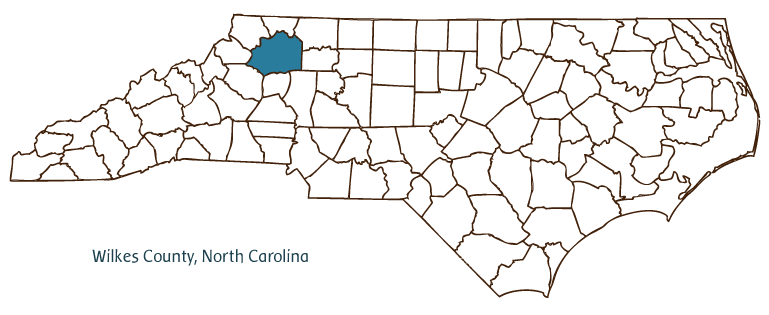Wilkes County Resources
- View All:
- Biographies
- Monuments
- locations
Copyright Notice: This article is from the Encyclopedia of North Carolina edited by William S. Powell. Copyright © 2006 by the University of North Carolina Press. Used by permission of the publisher. For personal use and not for further distribution. Please submit permission requests for other use directly to the publisher.

See also:"Ballad of Tom Dooley"; MerleFest.
Wilkes County, located in the Mountain region of North Carolina, was formed in 1777 from Surry County and named for the English statesman John Wilkes, a member of the Parliament who fought for American independence. Early inhabitants of the area included the Tutelo and Cherokee Indians; the region was later inhabited by German and Scotch-Irish settlers. Wilkesboro, the county seat, was incorporated in 1847 and named for the county. Other Wilkes County communities include Ronda, Roaring River, North Wilkesboro, Moravian Falls, Boomer, Ferguson, Millers Creek, Mulberry, Wilbar, and Austin. Physical features significant to the county are the Yadkin River and the W. Kerr Scott Reservoir.
"Tom Dooley" of legend and song was hanged in 1868 for the murder of Laura Foster in Ferguson. Wilkes County landmarks and historic sites include the Old Wilkes County Jail, built in 1858; the Robert Cleveland House, built in the late eighteenth century; Claymount Hill, built in 1870; and the Wade Hampton Harris Memorial Bridge, built in 1931. Cultural attractions include the Wilkes Symphony Orchestra, Wilkes Art Gallery, Wilkes Playmakers, and the Whippoorwill Academy and Village, including the Tom Dooley Art Museum. Natural attractions within the county include Stone Mountain State Park and the Rendezvous Mountain Educational State Forest. The county hosts festivals and annual events such as MerleFest, Brushy Mountain Apple Festival, Wilkes Agricultural Fair, Lowe's Balloons over the Blue Ridge, Mountain Bike Ride, and North Wilkesboro Fireworks Celebration.
Wilkes County farms produce such commodities as flue-cured tobacco, apples, poultry, and beef cattle; forestry is an important source of revenue in the county as well. Manufactured goods include hardboard siding, tools, milling equipment, glass products, lingerie, furniture, shoes, and hosiery. Wilkes County had an estimated population of 67,000 in 2004.
For an annotated history of the county's formation, with the laws affecting the county, boundary lines and changes, and other origin information, visit these references in The Formation of the North Carolina Counties (Corbitt, 2000), available online at North Carolina Digital Collections (note, there may be additional items of interest for the county not listed here):
County formation history: https://digital.ncdcr.gov/Documents/Detail/the-formation-of-the-north-ca...
Index entry for the county: https://digital.ncdcr.gov/Documents/Detail/the-formation-of-the-north-ca...
Additional resources:
Corbitt, David Leroy. 2000. The formation of the North Carolina counties, 1663-1943. https://digital.ncdcr.gov/Documents/Detail/the-formation-of-the-north-carolina-counties-1663-1943/3692099?item=4553233 (accessed June 20, 2017).
Wilkes County Government: http://www.wilkescounty.net/
DigitalNC, Wilkes County: https://www.digitalnc.org/counties/wilkes-county/
North Carolina Digital Collections (explore by place, time period, format): https://digital.ncdcr.gov
Image credits:
Rudersdorf, Amy. 2010. "NC County Maps." Government & Heritage Library, State Library of North Carolina.
Mazzocchi, Jay. "Wilkes County." NCpedia. State Library of NC. 2006. https://www.ncpedia.org/geography/wilkes.